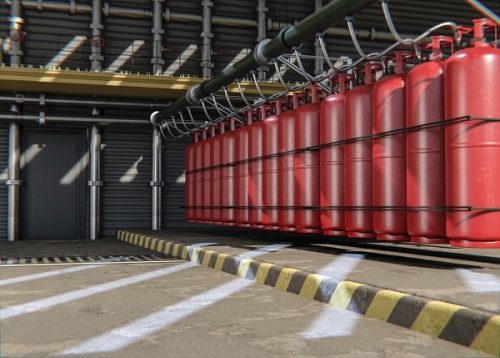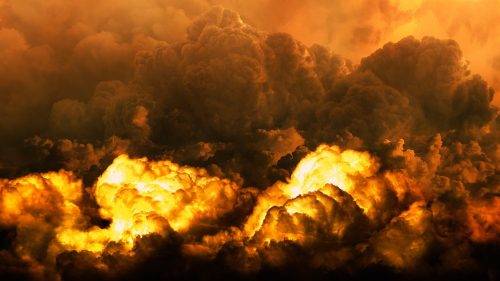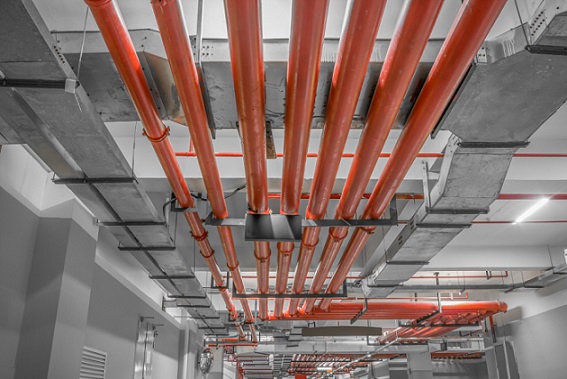
The Power of Gas Fire Suppression Systems
Gas fire suppression systems, also called clean agent fire suppression systems, represent a sophisticated approach to extinguishing fires without resorting to traditional water-based methods. These cutting-edge systems are precious in environments where water could cause substantial harm to delicate equipment or precious assets, such as data centres, server rooms, museums, and libraries.
Rapid Fire Defense with Oxygen Depletion
The fundamental principle behind gas fire suppression systems involves releasing a specialized gaseous agent into the protected space. This agent diminishes the oxygen concentration to a level below that which sustains combustion. The types of gases commonly employed in these systems include inert gases like nitrogen and argon and synthetic compounds such as FM-200 (heptafluoropropane) and Novec 1230.
Inert gases displace oxygen, creating an environment where fire cannot thrive. Halocarbon agents, on the other hand, interrupt the chemical chain reaction of the fire without depleting oxygen, offering a balance between efficacy and environmental considerations. Gas suppression systems are particularly advantageous because they can swiftly activate and suppress fires in their early stages and minimise potential damage.
Swift and Residue-Free: The Electrically Safe Advantage of Gas Fire Suppression
One notable characteristic of gas fire suppression systems is their capacity to act rapidly without leaving any residue. This feature makes them highly suitable for safeguarding electronic equipment and other sensitive assets. Moreover, these systems are electrically non-conductive, mitigating the risk of damage to electrical components during firefighting efforts.
The choice of a specific gas for suppression depends on factors such as the nature of the protected space, the types of assets within, and environmental concerns. It is imperative to adhere to safety standards and regulations during the design and installation of gas fire suppression systems to ensure their effectiveness and compliance with established protocols for fire protection.
Silent Guardians: Understanding the Mechanics of Gas Suppression Systems in Fire Safety
Gas suppression systems operate based on reducing the oxygen concentration in a protected space to a level where combustion is unsustainable. These systems can quickly and effectively extinguish fires without using water or causing damage to sensitive equipment. The specific mechanism can vary depending on the type of gas used, but here’s a general overview of how gas suppression systems work:
Detection and Activation:
Gas suppression systems are equipped with fire detection sensors that can quickly identify the presence of a fire in its early stages.
Once a fire is detected, the system initiates an alarm and activates the release of the gas suppression agent.
Gas Discharge:
The selected gas suppression agent is discharged into the protected space. The release can be rapid to ensure swift response and fire suppression.
The agent is evenly distributed throughout the protected area to achieve adequate coverage.

Fire Suppression Without Residue:
The gas suppression agent suppresses the fire without leaving any residue. This is crucial, especially in environments with sensitive electronic equipment where cleanup and restoration after a fire event need to be minimised.
Safe for Occupants:
Gas suppression agents are designed to be safe for human occupants. The gas concentration is carefully selected to ensure that it is effective for fire suppression while allowing for safe evacuation.
Electrically Non-Conductive:
Many gas suppression agents are electrically non-conductive, which is crucial in areas with electronic and electrical equipment. Features like this reduce the risk of damage to sensitive devices during firefighting efforts.
Reduction of Oxygen Concentration:
Inert Gases: Gases such as nitrogen, argon, or carbon dioxide work by displacing oxygen. As the concentration of oxygen decreases, the ability of the fire to sustain combustion diminishes.
Halocarbon Agents: Synthetic compounds like FM-200 or Novec 1230 interrupt the chemical chain reaction of the fire. They do not significantly deplete oxygen but interfere with the combustion process.

The Role of Gas Fire Suppression Systems in Safeguarding Sensitive Environments
The Role of Gas Fire Suppression Systems in Safeguarding Sensitive Environments
Gas fire suppression systems are typically employed in environments where traditional water-based fire suppression methods may not be suitable due to the presence of sensitive equipment, valuable assets, or the nature of the facility. Here are some situations and environments where gas fire suppression systems are commonly used:
- Data Centers and Server Rooms:
- Critical facilities housing servers, data storage, and networking equipment are highly susceptible to damage from water-based fire suppression systems. Gas fire suppression is preferred to avoid potential damage to electronic equipment and data.
- Telecommunication Facilities:
- Similar to data centres, telecommunication facilities, including communication rooms and equipment, often use gas fire suppression systems to protect against fires without causing damage to sensitive electronics.
- Control Rooms:
- Where control panels, electrical switchgear, and other critical systems are housed, environments may utilise gas fire suppression to protect against fire hazards while minimising equipment damage.
- Museums and Archives:
- Facilities housing valuable artefacts, rare documents, or irreplaceable items may opt for gas fire suppression to avoid water damage and protect sensitive materials from fire.
- Laboratories:
- Research laboratories, particularly those dealing with sensitive experiments, may use gas fire suppression systems to protect equipment and experiments without introducing water-related risks.
- Libraries and Archives:
- Similar to museums, libraries and archives housing rare books, manuscripts, and historical documents may choose gas fire suppression to prevent water damage.
- Power Plants and Substations:
- Facilities with critical electrical infrastructure, such as power generation plants and substations, may use gas fire suppression to protect against fires without risking damage to electrical systems.
- Medical Facilities:
- Areas with sensitive medical equipment, such as imaging rooms, may benefit from gas fire suppression to avoid damage to expensive and critical apparatus.
- Art Galleries and Exhibition Spaces:
- Environments showcasing artwork and exhibits may use gas fire suppression to provide protection without the risk of water damage.
- Military and Defense Installations:
- Critical military installations often require specialised fire suppression systems to protect sensitive equipment, communication centres, and strategic facilities.
Gas fire suppression systems offer a clean, effective, and rapid response to fires in these environments, making them a suitable choice where water-based systems may be impractical or risk-protected assets.
